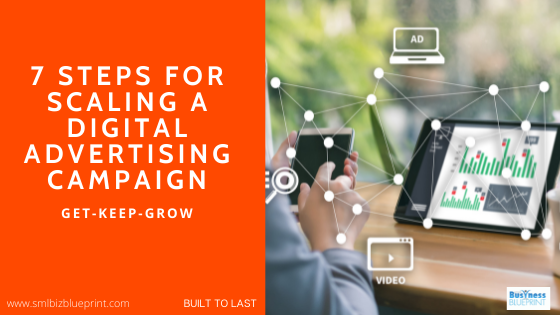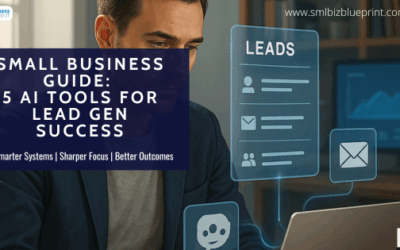Here are the 7 steps you’ll go through to plan, implement, and scale a Digital Advertising campaign.

Step 1: Identify your target market
Your target market (or ideal client, avatar as people say today) is a profile for one type of person who’d be interested in your offer (example: entrepreneur, stay-at-home mom, consultant).
The target market for your campaign should be the group of people who you solve problems for or who will benefit from your product or service.
The only exception here is when you are targeting a new market for your business.
Ideally you should have a profile of your target market. Just like all those criminal TV shows where the police have a profile of the suspect you should have a profile of your target market.
Now you probably have more than one target market. This is good because you should have a number of markets you can target with your product. You just don’t have the same message for each target market.
Step 2: Identify the Hooks
What’s most appealing about your offer?
Each benefit or outcome of your offer can be turned into a hook to grab the attention of your audience.
Generally, you’ll create hooks based on these 6 outcomes.
Have. What will they have if they download and consume your offer? How do their lives look before & after?
Feel. How will they feel better, smarter, or more successful for accepting your offer?
Average day. How did you change or improve their average day?
Status. How do people elevate in status or become a better person after consuming your offer?
Proof/results. What social proof, case studies, or testimonials validate your offer? How can you promote the sense of belonging that people will get from joining other people who’ve responded?
Speed and automation. Speak to the time savings or quickness of learning or applying the information in your offer.
Don’t feel like you need to create a hook for all these outcomes. But do be creative and come up with several benefits or outcomes that will grab the attention of your target market

Step 3: Create your ad copy
What is your message? What is the problem you are solving?
You need segmented messaging for every target market.
You want unique ad copy for every segment:
For each segment, you want the copy for the entire ad: text, headline, description and ad type.
So let’s say you have 4 target markets and 5 hooks, you’ll need to write 20 ads.
This level of segmentation gives you the best chance of success in your campaign.
Instead of creating generic ads for a few target markets or hooks, you’ll create highly targeted ads aimed at specific types of people (your target) with specific interests (hooks).
With this approach, your odds of getting a good return on your ad spend are incrementally higher!
The reason you want a number of ads with different headlines etc is so you can test.
You will run a test of your different headlines, images and copy and let the market (your target market) determine the winner.
Step 4: Research
Once your copy is written, it’s time to research your target market to identify the interest groups you’ll use in your ads.
For this, research each target market separately, finding the answers to each of these questions:
Who are the authority figures, thought leaders, or big brands in your niche?
What books/magazines/newspapers does your ideal customer read?
What events do they attend?
What websites do they frequent?
Where do they live?
What tools do they use?
What’s specifically unique about this group?
To find the answers, do a Google search and ask people in your target audience.
It may take time to find the answers, but these answers will help you get your ads in front of the people who need to see them. So take the time to do it right!
You should also use this little-known technique…
We call it the “But No One Else Would” trick, and here’s how it works.
Let’s say you’re targeting an ad to golfers. You want to find interests that only avid golfers would know about, so no one will click on your ad except qualified prospects.
Even casual golfers would likely know who Tiger Woods and Phil Mickelson are, but only avid golf enthusiasts would know Bubba Watson. So when setting up your ad, you’d want to target people interested in Bubba Watson.
This is what you’re looking for in your target market research: the interests that only die-hard fans would know about, so you can get the right eyeballs on your ads.

Step 5: Create Ad Creatives
Your ad creative is the visual element you’ll use in each ad.
At a minimum, you need one creative for each hook.
What should your creatives look like?
Do a Google image search of each hook’s keywords, and see what comes up.
Images for the Google search “golf tips” The top-ranking images show you what people think about when they hear your keyword.
Use that as inspiration.
But don’t copy.
Design original images or videos that include the imagery people associate with your keyword but that also have your brand’s unique look and feel.
Step 6: Set up your ads and compile your results
At this point, you have all the assets you need for your ad campaigns. It’s time to set up your ads.
Use your target market for your targeting.
Use the copy and creative you’ve developed to build the ads.
Use your target market interests to build an audience size in the range of half a million to 1.5 million each.
Then turn your ads on and run them for about a week. Once you start getting results, you can begin gathering your metrics.
Your best success metric depends on the purpose of your campaign and the temperature you’re targeting. It might be:
cost per click
cost per 1,000 impressions
cost per acquisition
ROI
Or some other metric that reflects your success
Ideally, you’ll collect the metrics at 7 days, 14 days, 21 days, and at the end of the campaign.

Step 7: Scale
Scaling is about figuring out what’s working, what’s not, and how you can get bigger, better results.
There are 2 ways to scale a campaign:
Horizontally: If your results for a target market are better than average, buy traffic on other ad platforms to boost your visibility to that group of people.
Vertically: If a specific hook or target market is working especially well, create more ad sets to that group on the same platform.
Find your winning target market and hooks, and scale those.
But also refine your process so you get better results in less time with a smaller investment of time or money.
Optimising Your Process
In digital advertising, your goal is to attract cold traffic, then warm it up over time, so you can effectively attract new people to your website, get them to opt in, and persuade them to buy.
To do that, you’ll build campaigns that include ads for all temperatures of your target audience.
The challenge is to stay within your budget while targeting different segments. Here’s how to optimise your ad spend.
Your formula for success is
Let’s assume your budget allows you to spend $10 a day.
Your daily spend will look like this:
$6/day on cold traffic, driving cold traffic to your site with pure content
$3/day turning warm traffic into leads or buyers
$1/day retargeting and selling a higher-dollar product
That ratio may change periodically depending on your needs, but this is a good balance, allowing you to target all temperatures while maintaining control of your spending.
Optimizing your Ads
When targeting different temperatures, you need to adapt your ads to the level of relationship.
These templates will give you a good head start.
Cold Traffic Ad
Warm Traffic Ad
Hot Traffic Ad
Optimizing a Weak Campaign
If a campaign isn’t performing well, go back to your offer.
If you have a powerful offer, your other elements can be weak and the ads will still work.
But if your offer isn’t right, nothing else matters.
In some cases, your ads will start out strong, but results will wane over time.
When this happens, it usually means ad fatigue has set in. People have seen the ad too many times and aren’t responding to it anymore.

You can fix ad fatigue in 2 ways:
Retarget to another audience.
Change out the campaign.
Traffic Temperature
The classification of the audiences you target with your digital advertising campaigns as cold, warm, or hot.
Cold Traffic
Audiences targeted with ads that have no prior experience with your brands, products, or people. Ads targeted at cold audiences introduce the business to the prospect and establish trust and authority in an effort to build awareness.
Warm Traffic
Audiences targeted with ads that are aware of your brands, products, or people but have not yet converted to a customer or haven’t purchased in a long period of time.
Ads targeted at warm audiences should be designed to convince a prospect that you have the superior solution.
Hot Traffic
Audiences targeted with ads that have previously purchased. These audiences know your reputation and have used your product or service.
Ads targeted at hot audiences should convert a customer into a high-ticket or repeat buyer. Most ad campaigns to hot audiences will be conducted through retargeting.
There with these steps you should be able to launch your campaign, test and review and then scale based upon your results.




